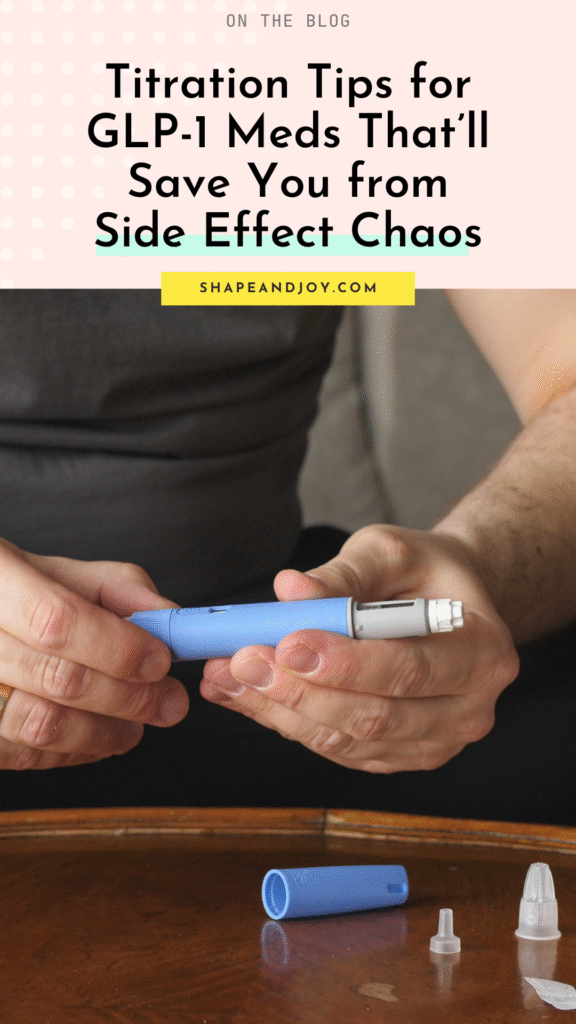This post may contain affiliate links, which means that I may earn a commission if you click on the link or make a purchase using the link. When you make a purchase, the price you pay will be the same whether you use the affiliate link or go directly to the vendor’s website using a non-affiliate link.

So, you’ve started a GLP-1 medication — and you’re ready to make some changes. You’ve prepped your protein, downloaded your meal plan, and braced yourself for a calmer appetite… And now your provider throws out the word “titration.”
Cue the blank stare.
If you’re sitting there wondering why you’re not on the “proper” dose yet, or why the side effects seem to come and go like the British weather — don’t worry, you’re not broken, and you’re not doing it wrong.
You’re just in the dose adjustment phase — also known as titration — and it’s completely normal.
This post will break down exactly what titration is, what to expect during each stage, how to support your body (without starving it), and why going slow is actually the smartest thing you can do. Because let’s be real: the goal isn’t to suffer through it — the goal is to feel good and get results that last.
Let’s get into it.
- What Is Titration (And Why Should You Care)?
- Typical Titration Schedule (Semaglutide vs Tirzepatide)
- Common Side Effects (And When They Show Up)
- What to Eat During Titration
- What NOT to Do During Titration
- Mindset Tips to Get You Through
- When Titration Ends and Maintenance Begins
- Final Thought: Take Your Time
What Is Titration (And Why Should You Care)?
Titration simply means gradually increasing your dose over time. With GLP-1 medications like semaglutide and tirzepatide, the goal is to introduce the medication slowly, so your body doesn’t freak out and leave you clutching your stomach wondering why you ever signed up for this.
It’s about easing your way in, so side effects stay manageable and your gut has time to adjust. Think of it as wading in at the shallow end instead of diving headfirst into icy water.
The slower approach helps your body adapt to the appetite and digestion changes that come with GLP-1 meds — and that means fewer side effects, better results, and a much nicer experience overall.
Typical Titration Schedule (Semaglutide vs Tirzepatide)
Let’s break it down:
Semaglutide (Wegovy, Ozempic):
- Weeks 1–4: 0.25 mg
- Weeks 5–8: 0.5 mg
- Weeks 9–12: 1.0 mg
- Increases continue every 4 weeks up to 2.4 mg
Tirzepatide (Zepbound, Mounjaro):
- Weeks 1–4: 2.5 mg
- Weeks 5–8: 5 mg
- Then increases every 4 weeks up to 15 mg
Not everyone follows the same schedule exactly. If your body needs more time to adjust, you can stay at a dose longer. It’s your journey — not a race to the top.
Common Side Effects (And When They Show Up)
Each new dose can bring a bit of turbulence. Even if you were fine on your starting dose, don’t be surprised if side effects pop up with the next increase.
The most common ones include:
- Nausea
- Feeling full quickly
- Bloating or constipation
- Burping (you might sound like a foghorn, it’s fine)
- Low energy or lightheadedness
- Food aversions, especially to rich foods or meat
This is totally normal. Your digestion is slowing down, and your hunger hormones are shifting. Some people breeze through it, others feel every bump along the way.
📌 Pin this for later! ⬇

What to Eat During Titration
When your appetite’s on the fritz and your stomach’s feeling fussy, you need meals that work with your body — not against it.
Here’s the golden trio: small portions, high protein, and easy digestion.
Stick with:
- Simple, high-protein meals (eggs, tofu, Greek yoghurt, fish, lean chicken)
- Fibre-rich veg like spinach, courgette, carrots, or blended soups
- Low-fat, low-sugar options that don’t overwhelm your gut
- Hydration and electrolytes to support energy and digestion
If you need inspiration, check out my GLP-1 Meal Plan packed with ideas that won’t make you want to gag by week two. I’ve also got plenty of Zepbound meals, semaglutide snacks, and protein-packed recipes that can get you through even the dodgiest dose increases.
What NOT to Do During Titration
- Don’t skip meals — even if you’re not hungry. Your body still needs fuel.
- Don’t jump to the next dose before you’re ready. You’re allowed to slow down.
- Don’t force foods that feel wrong — switch it up with smoothies, soups, or lighter meals.
- Don’t panic if your appetite doesn’t crash straight away — some people feel it more at higher doses.
This is a metabolic change, not a miracle zap.
Mindset Tips to Get You Through
This phase can mess with your head — especially if your weight loss hasn’t kicked in or your energy’s taken a dip. Here’s how to keep your cool:
- Track non-scale victories like reduced cravings, better control, or less food noise
- Use a symptom tracker so you can spot patterns and adjust meals accordingly
- Focus on habit-building over perfection — consistent GLP-1 friendly meals > all-or-nothing thinking
- Don’t compare your journey to someone else’s “I lost 10lbs in 2 weeks” nonsense
This isn’t about speed. It’s about building something that actually lasts.
When Titration Ends and Maintenance Begins
Once you hit your target dose — or the dose that’s right for your body — things start to feel more stable. Hunger levels even out. Your energy comes back. Food noise fades. And you’ll start feeling more in control of your eating and your day-to-day routines.
This is where your efforts start compounding. Those protein-rich meals, the walks, the strength training, the meal planning — they start paying off in a way that feels sustainable and freeing.
Final Thought: Take Your Time
There is no gold medal for hitting the highest dose first. Plenty of people lose weight and feel amazing on the lower or mid-range doses, especially when they combine it with:
- A simple, balanced GLP-1 diet plan
- Basic meal prep and planning routines
- Joyful movement or beginner strength training
- Small habit changes that actually stick
Going slower doesn’t mean you’re doing it wrong. It means you’re doing it safely, mindfully, and in a way your body will thank you for.
You don’t need to white-knuckle your way through this. You’re allowed to go steady — and still succeed.
Next Steps:
Still not sure which one is right for you?
- Grab my free GLP-1 Kickstart Bundle to help you get started on the right foot!
- Read: 5 Common Mistakes People Make on GLP-1s if your side effects are flaring or things aren’t going to plan — this can help you reset.
- Or dive into the GLP-1 Nutrition Guide to start eating for results
You’re not behind. You’re just getting started — and you’re doing brilliantly.
📌 Pin this for later! ⬇


